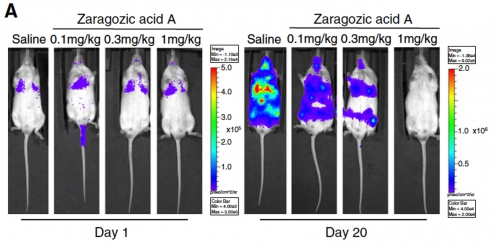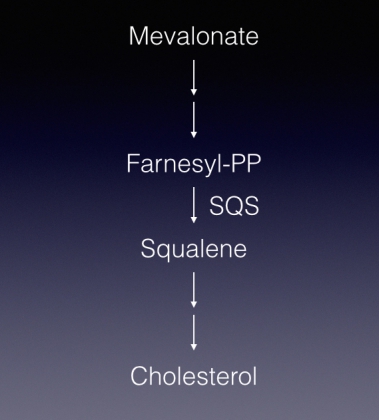Squalene synthase, commonly abbreviated as SQS, is an enzyme that has been shown to elevate cholesterol levels in mice when overly expressed. SQS has been linked with liver since no matter it is the good cholesterol or the bad cholesterol, the make of its origin is in the liver. However, in a collaborated study led by the primary investigator Dr. Michael Hsiao, the team combining a variety of expertise from pathology, stem cell, genomics, and clinical medicine, has redefined the role of SQS.
In the article published in the September 15th 2014 issue of “American Journal of Respiratory and Critical Care Medicine”, they not only showed the evidence of SQS as a novel lung cancer prognosis marker but also demonstrated its role in promoting non-small cell lung cancer (NSCLC) metastasis.
Ph.D. student, Yi-Fang Yang and Post-doc researcher, Yi-Hua Jan both contributed heavily in this study. They started their research careers in Dr. Hsiao’s lab way back in undergraduate days. They both determined to find better ways to help the physicians to have accurate prognosis marker and effective therapeutic modalities for cancer patients, especially for those who have high risk of metastatic recurrence.
One way to do it is to figure out how and why some patients are “cured” after the treatments, yet others would develop metastatic recurrence later where the cancer cells resurface in other parts of the body.
Their study began by using high-throughput immunohistochemistry (IHC) approach. They screened over thousands of antibodies that might recognize potential cancer biomarker in different kinds of cancer patients and identified SQS as the primary suspect in causing the spread of lung cancer.
Yang explains that, cholesterol is carried by Low-density lipoprotein (LDL) or High-density lipoprotein (HDL) circulating in blood. Moreover, cholesterol is also enriched in a structure on cell membrane called “lipid raft”, which can be regarded as a platform that allows signaling molecules and receptors to be locally integrated and makes signals efficiently transduced.
In metastatic cells, they tend to express higher SQS and make more cholesterol to reinforce lipid raft structure, thus, enhancing the receptors-mediated signaling to trigger metastatic dissemination. The finding is the first of its kind and the journal actually uses it as the cover story and cover picture.
According to Jan, a prior research paper regarding the lipid raft activation by SQS caught their eyes and in-spired this study. We used gene microarray to analyze gene expression changes upon SQS overexpression in lung cancer cells to narrow down the targets, we then found the activation of Tumor Necrosis Factor Receptor 1(TNFR1) in lipid raft is the major cause for lung cancer cells to invade and metastasize.
The team did more than just a thorough observation to explain the molecular mechanism. They also estab-lished a lung cancer metastasis animal model and proved that inhibition of SQS enzymatic activity is an effec-tive way to prevent the metastasis. Since SQS inhibitors are available, the team used such inhibitor to treat mice with lung cancer, or used a gene knocked down strategy to suppress SQS gene expression, all lead to the conclusion that, without SQS, there is much less chances for lung cancer cells to spread.
 |
| 80% of mice with human lung cancer cells that received high dose (1mg/kg) SQS inhibitor (Zaragozic acid A) were free of cancer cells after 20 days (Purple fluorescence indicates the cancer cells). |
“The analysis can be done when patients’ tissue is available.” , Hsiao explained, “ If SQS is measured in high level in the primary tumor, it is more likely the tumor may synthesize more cholesterol to build lipid rafts, therefore, it will have the tendency to develop metastasis later. Proper precaution care for such patients really matters then.”
Another observation is that although Statin is a commonly used medicine for lowering cholesterol level, Statin- treated cells did not show a significant effect on inhibiting lung cancer invasion/migration.
Dr. Hsiao expressed high hopes in their following works. They would pursue in finding better inhibitors to spe-cifically block SQS activity. It is also a good candidate as a cancer biomarker for physicians to predict patients outcome and make proper preventive measurements even the patients seem only at stage I or stage II.
The group effort was done with contributions from Dr. Chia-Ning Shen and Dr. Jean Lu of Genomics Research Center, Academia Sinica, Dr. Ming-Shyan Huang, Dr. Chih-Jen Yang, and Dr. Yu-Peng Liu of Kaohsiung Medical University Hospital, and Dr. Yuan-Feng Lin of Taipei Medical University.
